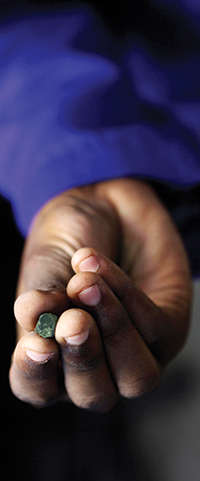|
Industry
Buyer Beware: Green Diamonds
Wholesalers have to be extra cautious when dealing in green diamonds or risk violating U.S. sanctions against Zimbabwe.
By Shuan Sim

|
| Above: Inside a polish and cutting shop in Harare, a Zimbabwean worker holds a piece of rough diamond from the country’s Marange diamond fields. |
Wholesalers attending a seminar at the Natural Color Diamond Association (NCDIA) in New York City expected to find out whether Zimbabwe green diamonds bearing Kimberley Process (KP) certification made them legal to trade. Instead, they learned that U.S. sanctions against the country made all diamonds from Zimbabwe — not just the green — off limits, regardless of whether or not they were KP certified.
In 2003, then-President George W. Bush signed an executive order for economic sanctions against Zimbabwe President Robert Mugabe, other individuals and companies. The sanctions were a response to the human rights violations by the Mugabe government, suspected money laundering and alleged funding of terrorist activities. Around that time, the European Union (EU) had imposed similar sanctions against Zimbabwe.
As the majority of the country’s diamond production came under Mugabe’s control, the sanctions effectively stopped diamond trading between Zimbabwe, the EU and the U.S. About ten years later, the EU, pushed by Belgium, lifted the bans on Zimbabwe’s diamond mining firms. However, the U.S. kept its sanctions in place.
Many seminar attendees asked speakers Cecilia Gardner, president, chief executive officer (CEO) and general counsel of the Jewelers Vigilance Committee (JVC), and Tom Gelb, educational director of NCDIA, what they could do to protect themselves. “The first thing is to ask for a certificate,” said Gardner. The onus is on the buyer to make sure that not only is the green diamond KP compliant, as the U.S. is a member of the agreement, but that the buyer should also ensure that the stone did not come from Zimbabwe.
Green diamonds are exceedingly rare. According to Gelb, Zimbabwe accounts for as much as half of global green diamond production. There has also been a dramatic increase in production because of increased activity in Zimbabwe’s Marange region. Guyana and Brazil are the other large producers of green diamonds.
Green diamonds started to take off in late 2014, when celebrities were seen sporting emeralds on the red carpet. “Diamond dealers started thinking that if emeralds were popular, why not green diamonds? We started having people asking us where to source for green diamonds and for the price range,” said Gino Di Geso, director of NCDIA.
Over time, industry players became aware of the issues involved in dealing in green diamonds: Namely, the fact that green diamonds were likely to have come from Zimbabwe and that they were illegal. “NCDIA members would ask, ‘Are we allowed to deal with these goods?’ and ‘Are they okay if they were KP certified?’” said Gelb, adding that the members mostly asked about the KP process. He said that knowledge of the U.S. sanctions against Zimbabwe was scant. “You have to go searching for it to even know about it,” said Gelb.
Many dealers did not know about the consequences of possessing Zimbabwe green diamonds. “I sort of knew about the issues concerning Zimbabwe and I knew about the sanctions, but the seminar showed me the details of the regulation,” said attendee Ishay Ben-David, owner of Ishay Ben-David Corp., a wholesaler of natural colored diamonds. The seminar explained that the U.S. government could do what is called a “claw back,” where the government could simply go into a dealer’s bank account and take money out of it for the value of the diamond or profits derived from the sale of it. The government could also indict an individual for criminal conduct or sue civilly for violating sanctions, according to Gardner.
Wholesalers were not pleased to learn how easy it was to fall afoul of the law. “It seems that there is not much you can do to protect yourself,” said Kushal Sacheti, CEO of Galaxy USA Inc. in New York City. “The law is so vaguely defined and nobody can prove or disprove if a diamond is from Zimbabwe,” he said.
Once a diamond is cut, it is very hard to prove its origins. Furthermore, as green diamonds receive their color from radiation, which penetrates the stone to varying depths, it is possible for a green diamond to end up appearing like a D flawless stone when cut and polished, making it difficult to pinpoint its origin, said Gelb.
This presents a problem for traders, who only have the guarantee from sellers that their diamonds did not originate in Zimbabwe. “The government, which is tracking these stones, knows they are from Zimbabwe but we don’t,” said Sacheti. “Even if we ask and are told they are not from Zimbabwe, if they end up being from Zimbabwe, there’s nothing we can do.”
Some wholesalers believe that their experience helps them identify Zimbabwean green diamonds. “They have a sort of grayish yellow tint to them,” said Ben-David. However, Gelb felt that such anecdotal practices are not foolproof. “This may be the standard practice for diamond dealers, but from the point of view of science, any diamond that came from Zimbabwe could certainly look like it could have come from somewhere else,” he said.
Currently, the availability of green diamonds is still so low that it remains mostly a collector’s market, though that might change in the future. “It is certainly the fastest-growing color aside from pink and blue,” said Di Geso.
While demand for that color grows, the politics hanging over Zimbabwe diamonds are not likely to change in the near future, according to Gardner. “The Zimbabwe government hasn’t really changed much,” she said. “I guess we just have to be extraordinarily careful,” concluded Sacheti.Article from the Rapaport Magazine - June 2015. To subscribe click here.
|
|